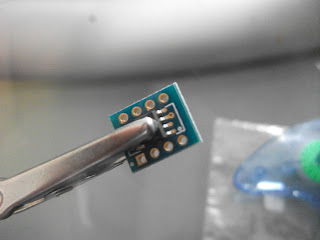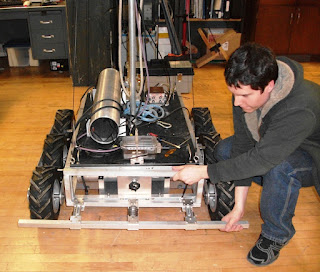Last month I completed my thesis and graduated with a Master's in Mechanical Engineering from UW-Milwaukee. My thesis was a tactile sensor system for the marine robot LMAR, a mobile platform for scientific experiments, designed to drive into the surf of lake Michigan carrying any sensing or sampling equipment required. The issue I came in to solve is navigational sensing; the water is turbulent and full of mud and crap.
At first I considered some sort of antennas, but those would likely break. A bumper seemed too blunt, but I am an engineer, so I made a highly sensitive bumper. It's shock mounted to move forward and back. I ended up using magnetic displacement sensors, when I first saw them I thought they might be too unreliable due to interference, but when I tested them they proved highly precise and very low noise, plus since they have no moving joints they are easy to waterproof.
They take the form of a tiny microchip (HMC1501 if you need one). I had to mount it on a breakout board since this project didn't have time for a custom PCB. Since they worked best in a range of about 20 mm I mounted the magnet and chip on beams that would move past each other as the shock absorbers compressed.
I used some plastic I beam that fit directly on to the shock mounting plates. Shown above without springs.
To back them up I added some simple accelerometers. They are cheap and require no amplifiers, plus they are good at picking up high frequency vibration, though they are not absolute in position, the magnetic sensors have that covered.
The circuit board takes care of power supplies for the logic and amplifiers, as well as reading the analog data and transmitting it to the main computer of LMAR. Besides that I wrote some testing software that plots readouts for debugging. I did that in processing because it was quick. Looking back on it I should have just used labview since it has data logging readily available and that's what they use for the robot itself, which is controlled by a cRIO.
Then of course there was writing the thesis, I won't bore you with the details of that. But it got approved. Here's how the bumper looks on the robot.
Next time, an update about how I made a $20 syma helicopter radio controlled.





No comments:
Post a Comment